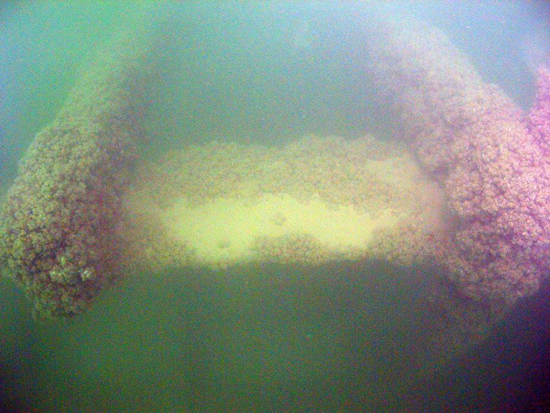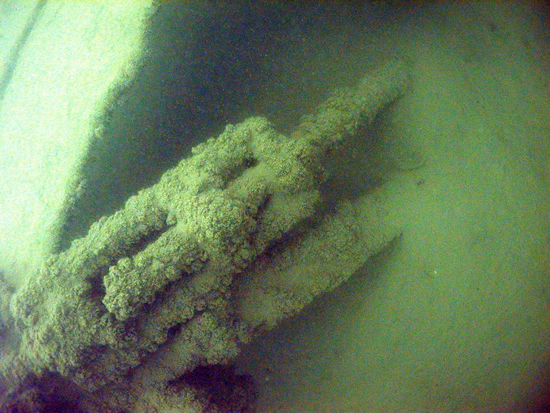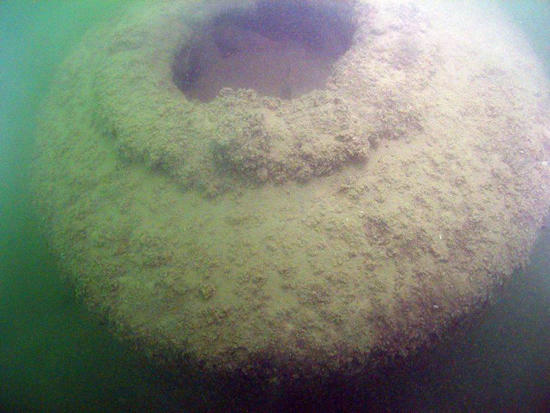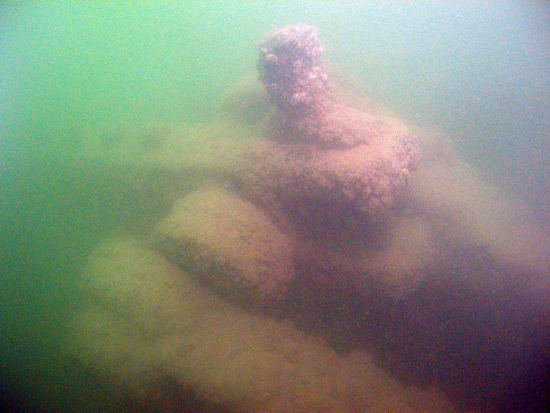Anthony Wayne
| Ship Name: | Anthony Wayne |
|---|---|
| Also Known As: | General Wayne, Wayne |
| Type of Ship: | Sidewheel Steamer |
| Ship Size: | 156' x 26' x 10' |
| Ship Owner: | Charles B. Howard and Co., and Captain E.C. Gore |
| Gross Tonnage: | 400 |
| Net Tonnage: | NA |
| Typical Cargo: | Passengers and miscellaneous freight, livestock |
| Year Built: | 1837 - Perrysburg, Ohio, by Samuel Hubbell, rebuilt in 1849, Detroit, by D.W. Donahue, and received new boilers |
| Official Wreck Number: | None - not located |
|---|---|
| Wreck Location: | FOUND! May 20, 2007! |
| Type of Ship at Loss: | Same |
| Cargo on Ship at Loss: | 80-100 passengers, 300 barrels of wine and whiskey, some cattle and horses |
| Captain of Ship at Loss: | E.C. Gore. Captain and half-owner of the vessel |
Observations on May 20, 2007, by CLUE research diver Tom Kowalczk: The wreck is in two sections. The 26 foot diameter side wheels, the foot-wide engine shaft and other parts were identified.
For more information about the Anthony B. Wayne, including Cleveland T.V. 3 coverage of the discovery, visit the CLUE website at:
http://www.clueshipwrecks.org/
FOUND! By shipwreck researchers from CLUE (Cleveland Underwater Explorers) in cooperation with GLHS/PLESRC. The public announcement was made on June 21, 2007, during a press conference at the GLHS in Vermilion, Ohio. Tom Kowalczk, a CLUE member, located the wreck in September 2006. The location has not been revealed at this time.
Observations on May 20, 2007, by CLUE research diver Tom Kowalczk: The wreck is in two sections. The 26 foot diameter side wheels, the foot-wide engine shaft and other parts were identified.
The following description of "The Shipwreck Today" was provided by The Cleveland Underwater Explorers (CLUE), based out of Cleveland, Ohio. Their write-up is based upon observations made during their first two dives to the Anthony B. Wayne in the spring of 2007. CLUE member Tom Kowalczk had located with side-scan sonar what he believed to be the Anthony B. Wayne during the fall of 2006. Typical fall Lake Erie weather conditions prevented the CLUE divers from actually diving on the site to verify what Tom Kowalczk's side scan sonar located the past fall.
The description of the wreck is very detailed by CLUE divers, and provides a wealth of information for the Great Lakes Historical Society, Peachman Lake Erie Shipwreck Research Center in Vermilion, Ohio; a partner with CLUE in the search for and discovery of the A.B. Wayne.
CLUE divers were the first to see the Anthony B. Wayne prior to her loss on April 28, 1850.
The following was taken verbatim from the CLUE website (http://www.clueshipwrecks.org) with their permission:
The Steamboat Anthony Wayne disaster resulted in one of the most significant loss of life in early steamboat history, estimate at 38 passengers and crew. Built only 19 years after the very first steamboat on Lake Erie, the Walk-in-the-Water, and rebuilt in 1849, the Anthony Wayne is believed to be the oldest steamboat shipwreck in Lake Erie. Important for its historical and archeological value, the Anthony Wayne is truly a treasure ship of Lake Erie.
CLUE, 2007-05-20 - Tom's Sidewheel Steamboat Wreck (Anthony Wayne)
On Sunday, May 20, 2007, Tom Kowalczk, David VanZandt, and Kevin Magee - all members of the Cleveland Underwater Explorers (CLUE) - went out on Lake Erie for the first dive of the season. They departed from Tom's marina on his boat Dragonfly, which is based at Marblehead near Sandusky, Ohio. The day was sunny, breezy, and cool with an air temperature of about 60 degrees F. The seas were initially two to three feet, but the wind was blowing briskly out of the northeast, causing whitecaps. By the time they reached the wreck site, the seas were three to four feet.
The dive site was a new wreck found by Tom during the 2006 season in about 50 feet of water. From the side scan images there are two discernable major pieces that appear to be the remains of a sidewheel steamboat. The bow appears to be partially visible, and sidewheels appear to be present in the other piece of wreckage. Tom did not dive this wreck when it was found last year. The boat was anchored, and Tom was the first to descend to investigate. Unfortunately, he discovered the anchor had dragged on the bottom and the wreck was not near the anchor. Bottom conditions were acceptable at a warm 55 degrees F, bright ambient lighting, and three feet of visibility. After surfacing, sea conditions deteriorated with waves building to three to five foot. However, persistence prevailed, the wreck was relocated, and after several attempts, the anchor was holding.
Since the seas were rough Dave decided to remain aboard for safety while Tom and Kevin investigated the wreck. Tom was the first to descend and found the anchor on the northwest corner of the wreck. Moving southwest, a standing sidewheel and hub were immediately found. The sidewheel is mostly broken, but parts of the lower half remain. A small standing portion of the hull's side was also seen near the sidewheel. It consisted of frames, ceiling, and planking. Turning northeast at the hub, the main shaft for the sidewheel was seen with large bearings holding the shaft in place. Continuing to the other sidewheel, it is in better shape with the upper half missing but the lower half mostly intact. The wheel's dimensions obtained were a radius of about ten feet and a width of about eight feet. There are multiple buckets (paddles) side-by-side within each sidewheel, and the out bucket width measured at two and a half feet.
Moving back along the shaft towards the middle of the wreck, the shaft is split in half at the middle and has a crank coming off the end of each shaft that rise up diagonally together towards the south. These cranks are several feet long and are attached by a very large pin joint to a single rectangular cross-section beam, a Pitman arm, made of metal with a prominent single row of nuts running down its length in the middle. It proceeds south downwards until it runs into the bottom near the base and slightly to the west of what would appear to be a single standing vertical cylinder with a small hole in the top. Peering inside revealed it is almost completely filled with silt. No more wreckage was seen beyond this point. Returning to the shaft, some additional wooden structure was seen to the north but did not extend far. Also seen was a rope running along the length of the Pitman arm with a Y-splice halfway down its length. This could be a line from nets, although no nets were found. No boilers or engine were seen during the dive.
A maximum depth of about 50 feet was obtained during the dive with visibility of about two to three feet. Unfortunately, bottom visibility did not allow a better survey to be performed, and topside conditions did not allow another dive to be performed. The trip back to the marina was slow through the heavy seas, but everyone was happy and excited about this newly discovered shipwreck. More dives and better measurements will be needed to properly evaluate the wreckage and confirm its identity.
CLUE, 2007-05-28 - Tom's Sidewheel Steamboat Wreck (Anthony Wayne)
On Monday, May 28, 2007, Tom Kowalczk, David VanZandt, Kevin Magee, and Cindy LaRosa headed back out to the sidewheel steamboat wreck to better document the wreckage. They departed from Tom's marina on Tom's boat Dragonfly. The day was much better than the previous trip. It was sunny and warm with the seas calm at less than one foot and almost glassy at times. A pleasant ride to the dive site was filled with excited talk about the possible identity of the wreck. Once anchored at the wreck site, Dave was the first in the water to videotape and photograph the wreck. He was followed by Tom, who explored the wreck more thoroughly. Cindy and Kevin entered the water last to obtain measurements.
Visibility on the bottom was unchanged at about two to three feet and the anchor was at the southwest corner of the wreck. The hull sections on each side were found to be much more substantial than originally noticed but did not extend far beyond the sidewheels themselves. The southwest sidewheel was found stripped of its outer arms with just an exposed hub outboard. The northeast sidewheel is more intact with a nearly full set of undamaged buckets on the lower portion of the wheel. Each bucket is divided into three sections with two center radial supports. The total width of each bucket is eight feet with the center section about five feet long. The inner and outer sections of the buckets to the housing edges measured three feet each. The radius of the northeast sidewheel was measured to be 12 feet (24 foot diameter), and 20 arms were counted around the northeast hub.
Moving to the centerline of the sidewheel shafts, the cranks and connections to the Pitman arm were examined in more detail. The width of the wreck measured 25 feet at this point with 13 feet to the centerline between the two shafts. The wooden structure to the north could be seen to be a 66-inch long by 69-inch wide box around the crank rod's range of motion in this direction. The sidewheel shafts measured one foot in diameter. The cranks measured approximately three feet in length to the pin joint. The pin joint is actually quite complicated and appears to have an extra linkage connecting the crank to the Pitman arm on the east side. The Pitman arm's length measured 20 feet before disappearing into the silt. Its cross section near the pin joint is 6 inches wide by 12 inches high. The cylinder standing near the end of the Pitman arm measured 28 inches in diameter and 38 inches high. The hole in its top measured 9 inches in diameter. No machinery is associated with this vertical cylinder, and there was a small open space underneath it. We suspected it to be an air expansion cylinder for the steam engine.
Not noticed on the May 20 dive to the east side of the pin joint of the Pitman arm was another standing cylinder with a cross head linkage at the top and machinery and piping coming off its side. The cylinder measured 18 inches in diameter. There are also two connecting links that come off the sidewheel shaft on the west side and extend south before turning 90 degrees downwards and disappear into the silt. We suspect these are control linkages that run off cams on the shaft to the slider valves that control the steam engine's operation. All of the equipment observed is consistent with a high-pressure horizontal steam engine with the engine and boilers probably buried low in the hull underneath the silt to the south. This, combined with the orientation of the buckets on the sidewheels, makes the south the likely direction of the bow. This is also consistent with the side scan images which show the suspected bow in this direction. Due to the poor visibility, however, the bow was not investigated.
Also discovered was a piece of PVC pipe towards the south end of the wreck. The line running along the Pitman arm was also noticed to extend exactly along the ship's centerline in both directions, suggesting it may have been purposely placed to orient divers on the wreck. Tom used a pole to probe for wreckage under the silt in both the north and south directions and discovered substantial wreckage underneath the silt for a significant distance.
The location, dimensions, and observed features suggest the identity of the wreck is most likely the sidewheel steamboat Anthony Wayne, which sank on April 28, 1850, when one of its high-pressure boilers blew up. Historical research has determined that the Anthony Wayne had a beam of 27 feet, its sidewheels were 25 feet in diameter, and it had a high-pressure horizontal steam engine. This engine replaced its original vertical steam engine, and it was removed from the steamship Columbus after it ran aground and was destroyed in 1848. The Anthony Wayne was claimed to have been located by modern divers in the early 1990's. They unsuccessfully petitioned the state of Ohio for salvage rights to the ship for the purported gold rumored to be on it.
Extensive historical research by Tom Kowalczk and Jim Paskert suggest that no sidewheel steamboat other than the Anthony Wayne is known to have wrecked at or near this location. The measured and observed physical evidence that has been obtained are also consistent with the historical description of the Anthony Wayne. Therefore, it is CLUE's opinion that this is the wreck of the sidewheel steamboat Anthony Wayne.
April 28, 1850, Vermilion, Ohio approximately 8 miles offshore. Two starboard boilers exploded in early AM hours resulting in complete destruction of the vessel. Explosion is a mystery, as boilers were virtually new. Had taken on 25+ passengers in Toledo on the morning of April 27, steamed to Sandusky, and picked up another 40+ passengers and 300 barrels of high quality wine and whiskey, and was enroute to Buffalo, NY. Captain was asleep and was blown out of his bed but was unhurt. Survived in a lifeboat with the ship's clerk, a fireman and two passengers, which drifted to shore in Vermilion. The captain secured a sailing schooner (Elmina) and returned to the site where some who remained afloat were rescued. Some passengers survived by standing atop the hurricane deck, which was blown into two pieces, allowing it to remain afloat. It was reported the steamer sank bow first in 15 minutes, taking six of the crew down with her in what was left of the steering cabin. One leaky lifeboat was able to be launched, with 12 passengers reaching shore after bailing continuously for six hours. Eleven of the crew died, in addition to an estimated 50-69 passengers (ship's manifest was unclear as to how many boarded at each location). The ship's clerk reported 80-100 passengers aboard (which included the crew) with no more than 30 surviving.
Many passengers were burnt badly by the scalding boiler water, while all passengers, wet from the sinking, suffered from the cold water temperatures. Survivors reported passengers were jumping from the ship with anything that may keep them afloat, such as cabin doors and wooden tables.
Although morbid, this is a fairly interesting account of death and survival.
Mr. Archer Brackney, from Lafayette, Louisiana, was a escorting the remains of his deceased wife and son; both corpses being in the same coffin, for burial in Philadelphia. In addition to the remains of his family inside the casket, Mr. Brackney was also accompanied by a daughter and another son; a sad trip for a family to be making. After the explosion, which roused the three passengers from berths, Mr. Brackney gathered his two children and jumped overboard. While attempting to keep afloat with his children, he searched the water for a floating object to help with their survival. Ironically, he came upon the coffin containing his wife and child, upon which he placed his two children. Exhausted from trying to stay afloat, the young boy was eventually washed off the coffin and drowned. Mr. Brachney and his daughter managed to survive the disaster, but only with the help of the coffin containing the remains of his wife and child.
Investigation by shipwreck researchers and salvagers during the late 1980s and early 1990s indicated the Anthony B. Wayne may have been carrying a safe containing approximately $100,000 in gold coins, which in today's market would be worth millions. It was also thought that the captain's strongbox may have contained another $1,600 in gold coinage. Part-time salvagers from Cleveland claimed to have located the shipwreck in 1988 in 66 feet of water, indicating the steamer to be partially buried in silt, requiring extensive salvage efforts to get through the mud and silt and into the hull. The salvagers, Matthew Roalofs and Kellog Vance, both of Cleveland, Ohio, believe their research indicates the gold exists. Others, including the Ohio Historical Society's deputy preservation officer Franco Ruffini, disagree. In 1989, a salvage permit was applied for by Roalofs and Vance to the State of Ohio, but was declined.
Federal and state law both indicated the wreck belonged to the State of Ohio, yet Ohio had not developed any type of law regarding salvage procedures. This law, from a bill (HB-264) introduced in 1991 by State Representative John Bara (D-Elyria), was passed and took effect later that year.
This law reserves shipwrecks deemed as historic to be the property of the state, and allowed for the state to choose their own salvage company if any salvage was warranted. Shipwrecks classified as "non-historic" would permit salvagers to keep 100% of their findings.
To date, the location of the wreck remains a mystery, or the location has not been revealed to others by Roalofs and Vance, who claim to have located the wreckage.
The following article appeared in the Daily Queen City Newspaper, Buffalo.N.Y. on Tuesday, April 30, 1850
TERRIBLE EXPLOSION.
(By O'Reilly's Western Telegraph.) Terrible Steamboat Explosion - Total Loss of the Steamer Anthony Wayne and From 60 to 80 Lives. Cleveland, Monday, April 29, 10 A. M.; From the Clerk of the Wayne, Mr. H.S. Vorse, who arrived here last night, we learn the following particulars:
The Wayneleft Toledo at 9 o'clock on Saturday morning, with about twenty five passengers and took on some forty more at Sandusky on Saturday night, leaving there at 10 o'clock. These, and the crew made the number on board from ninety to one hundred. About half-past 12 this A. M., (Sunday,) just below Vermillion, and some eight miles from shore, the two starboard boilers exploded throwing them into a perpendicular position, tearing away the steerage cabin above and shattering the hull badly. She sank in fifteen minutes, going down head foremost. The yawl was launched and twelve persons reached shore in it.
The life-boat half filled on launching and leaked badly, but six persons got ashore in her after six hours exertions by bailing constantly. Capt. Gore, James Edgcomb, 1st. mate, the 2nd. mate and Mr. Vorse, Clerk, are saved. Mr. J Ellmore, 1st, and Mr. Edward Burch, 2nd. Engineers are lost. Mr. D.A. Eddt, of Cleveland, was onboard, and was seen after the explosion, but whether he was saved is not known. The state room of the Captain next to the steerage cabin was blown to pieces and his bed was blown up side down, but her was unhurt.
When the Waynewent down she was on fire, and the flames were just bursting out. The cause we cannot state. The boilers were only a year old and in good condition. A fireman who escaped says that just before the accident he tried the boilers and there was plenty of water in them.
The Hurricane Deck is supposed to have floated and was thought to be seen from shore this morning. Two small vessels went out from Vermillion to pick up any survivors.
Our citizens will wait with painful anxiety to learn further particulars, and the fate of Mr. Eddy, one of their esteemed townsmen.
FURTHER PARTICULARS. Monday, 9 A. M. - One of the vessels which went out took off of the Hurricane Deck some thirty passengers, six dead. D.A. Eddy is safe and has telegraphed from Sandusky.
We learn further that the boilers were entirely new last season, and were built and put in under the superintendence of Wolcott, of Detroit. The engine is the one which was formerly in the Columbus. She exploded off Vermillion on her way from Sandusky to this port.
The Wayne was owned by Charles Howard & Co., of Detroit, and was running in opposition to the regular Sandusky line.
Daily Queen City, Buffalo; Tuesday, April 30, 1850
GLHS/PLESC archives
History of the Great Lakes
Cleveland Herald, April 29, 1850
Elyria Chronicle Telegram, June 21, 2007
Cleveland Plain Dealer, June 21, 2007
Columbus Dispatch, September 5, 1991 (Michael Lafferty, "LAKE ERIE STEAMER CARRIED GOLD TO BOTTOM, SALVAGERS BELIEVE"
Cleveland Plain Dealer, 9/10/91
Lloyd's Steamboat and Railway Directory and Disasters on the Western Waters, E. Lloyd, 1856
MARITIME HISTORY OF THE GREAT LAKES: a "digital library" - http://www.hhpl.on.ca/GreatLakes/HomePort.asp The Maritime History of the Great Lakes is managed by Walter Lewis
Great Lakes Shipwrecks and Survivals, William Rotigan
Ghost Fleet of the Perilous Passage, Gregor











